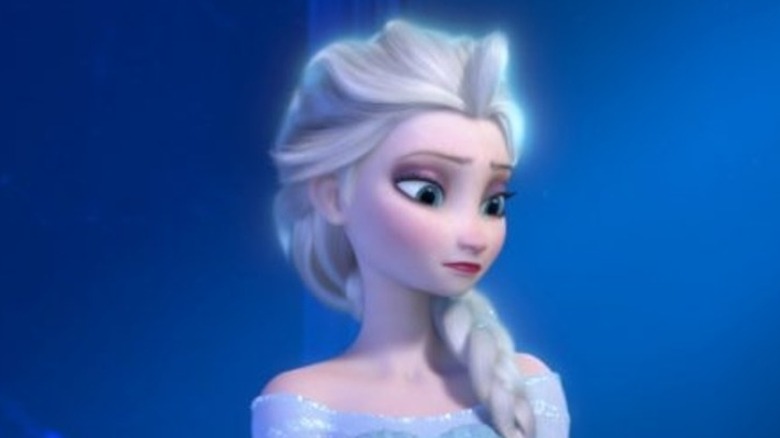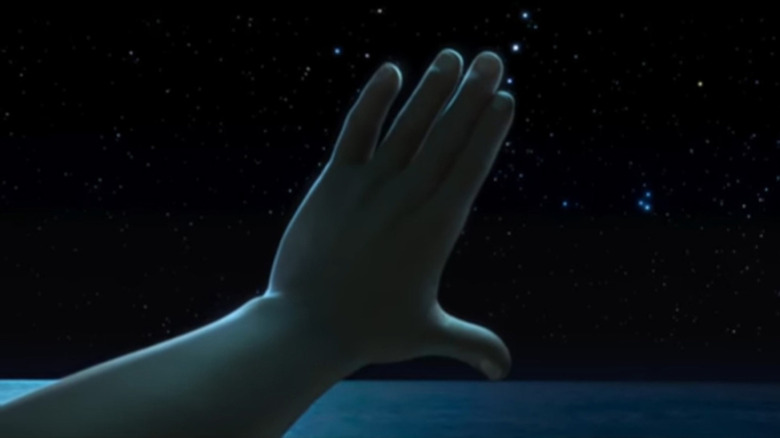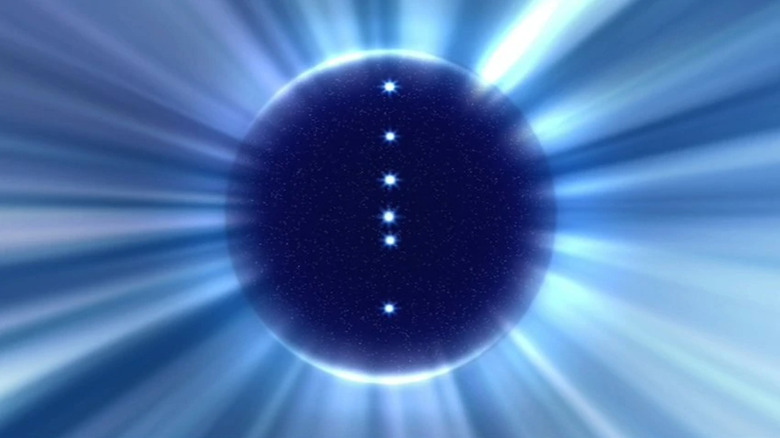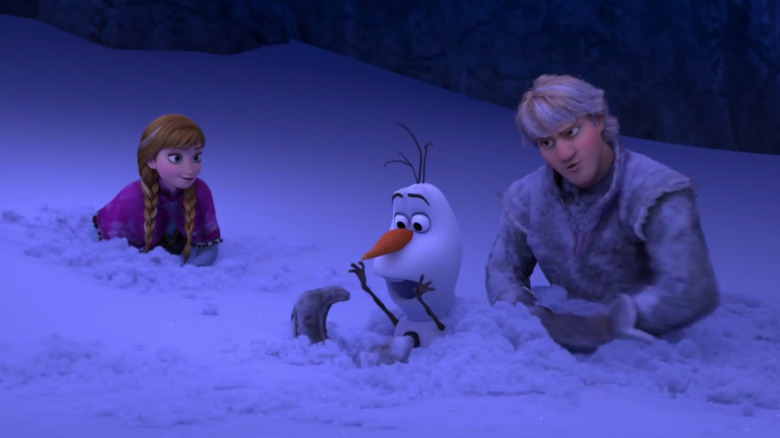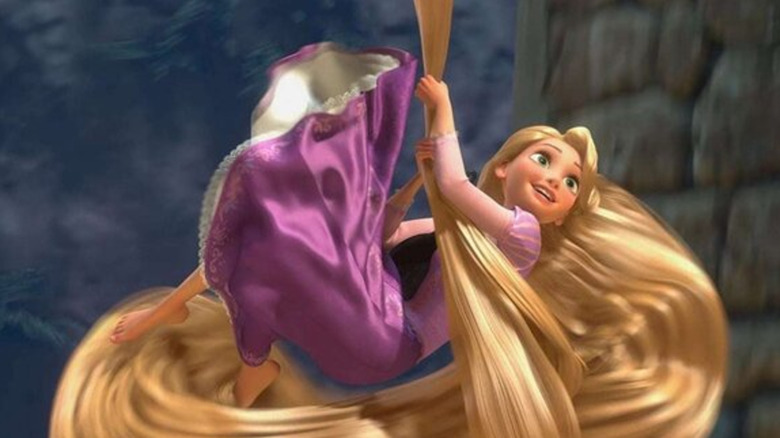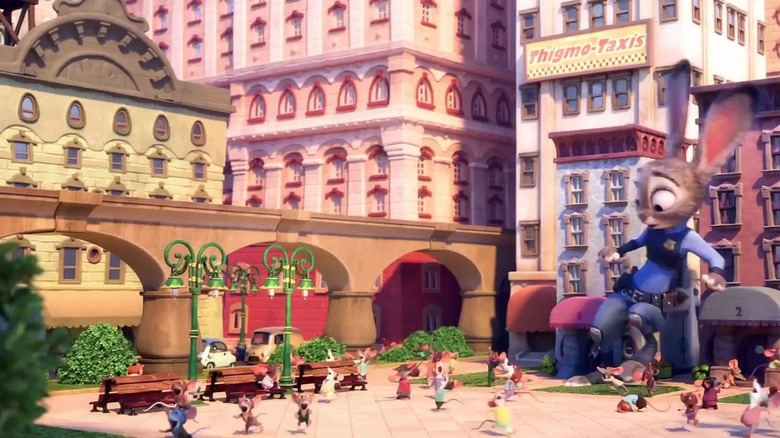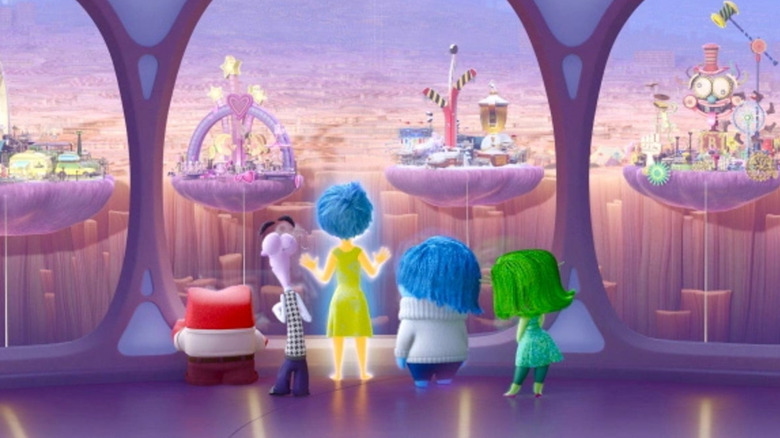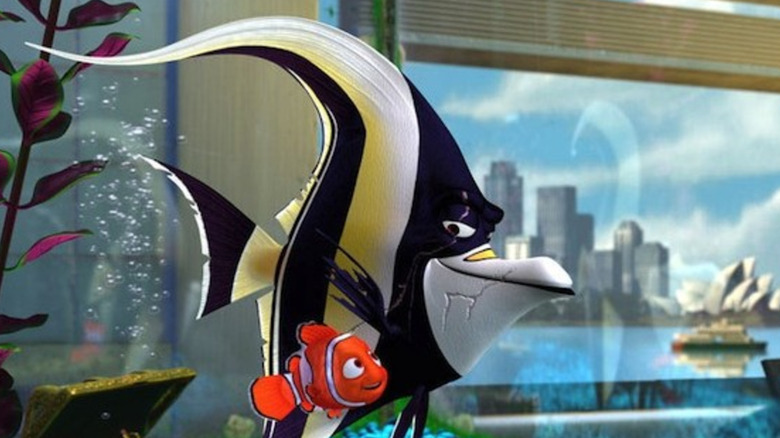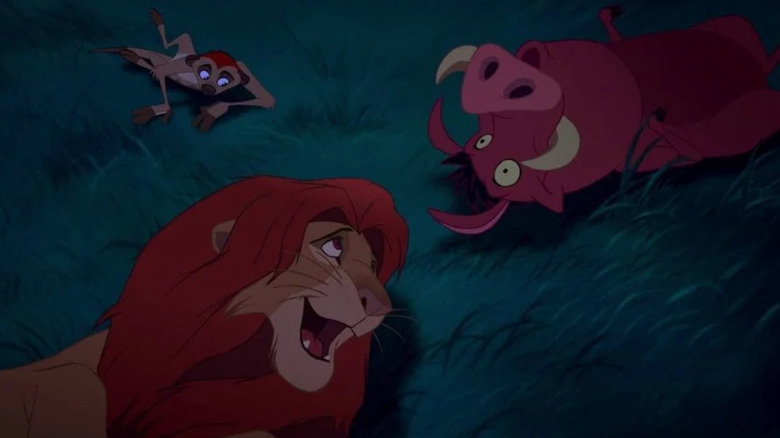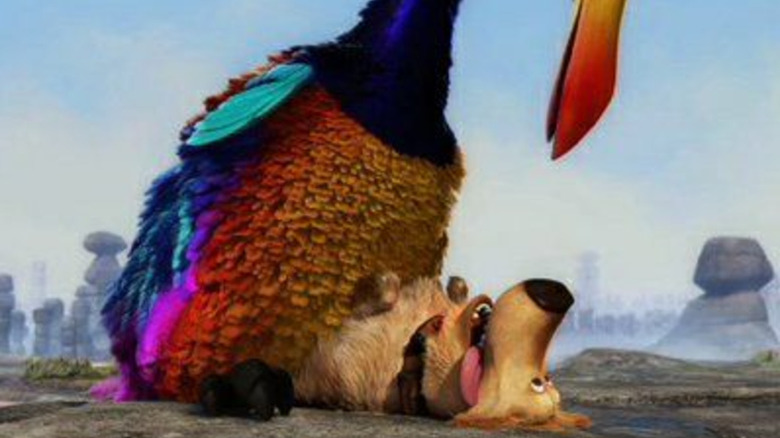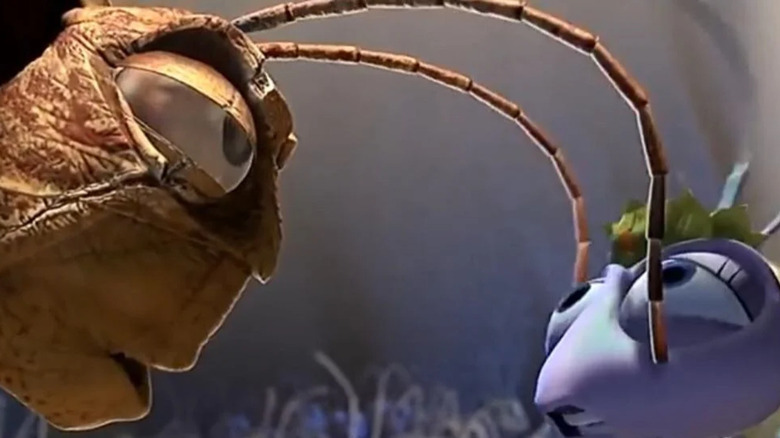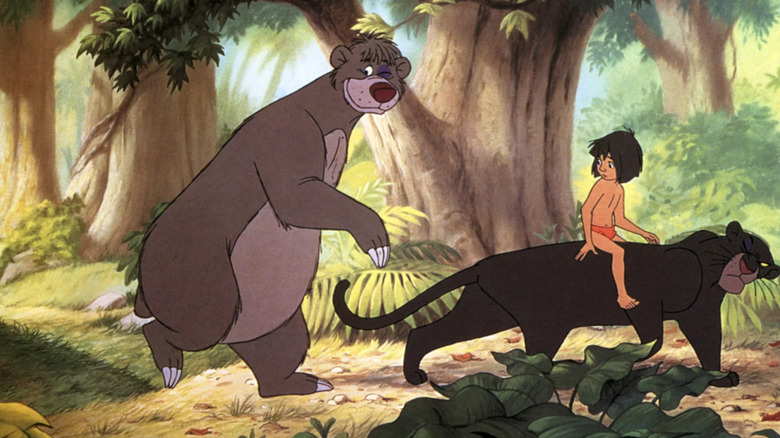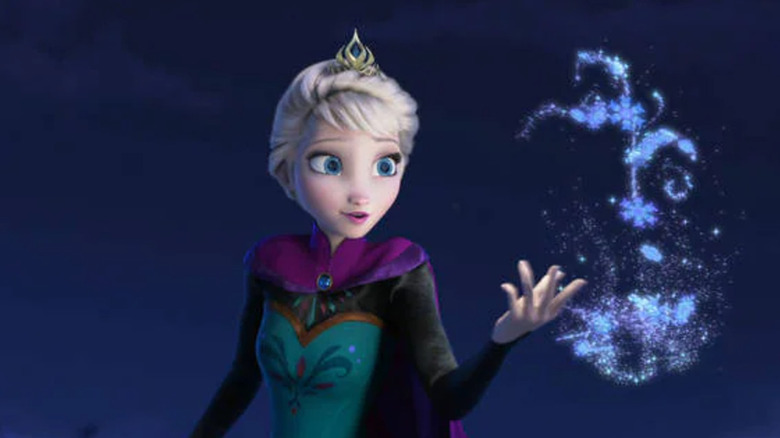Things Disney Movies Actually Got Right About Science
Disney movies typically aren't the first ones we name when thinking of scientifically accurate filmmaking. Most Disney films, especially the animated ones, are fictional — recreations of classic myths and fairytales and fantastical metaphors and allegories for real-life people and problems. But there are still quite a few Disney movies that rely on real-world science even as they lean farther into fantasy.
Sure, "The Jungle Book" Mowgli being safely raised by a bear and a black panther stretches believability, as do appearances by orangutans in India. There also aren't any humans with ice-wielding powers like Elsa in "Frozen." According to psychologist Nathaniel Herr, our brains do not have "personality islands" like the ones shown in "Inside Out," and the spotted hyenas in "The Lion King" wouldn't be scavengers like they are portrayed in the film (per National Geographic).
Still, these movies and many others contain moments of scientific accuracy. Here are some things in Disney movies that get a thumbs up from scientists for their accuracy.
Wayfinding in Moana
Long before compasses, maps, and GPS, Polynesian explorers used wayfinding to navigate their sea voyages. Educators at the University of Hawaii's Exploring Our Fluid Earth called the early Polynesian explorers some of the best wayfinders in history because of their methods of navigating the vast Pacific Ocean using the positions of the sun and stars.
Disney's "Moana" (2016) showcased one type of traditional wayfinding when main character Moana (voiced by Auli'i Cravalho) learns how to use her hand to keep track of the positioning of the stars in the night sky. Specifically, Moana measures the position of the stars in the Orion's Belt constellation to determine in her ship is headed in the right direction. Maui (voiced by Dwayne "The Rock" Johnson) tells her wayfinding is all about "seeing where you're going in your mind" and "knowing where you are by knowing where you've been."
According to New Zealand's Science Learning Hub-Pokapū Akoranga Pūtaiao, traditional wayfinders are experts at reading nature, constantly observing the position of the sun and stars and even the "feel" of the ocean. Educators say it's all about memory, like being able to memorize more than 200 different stars and where and when they move in the night sky.
The planetary knowledge of the ancient Greeks
The 1997 Disney animated film "Hercules" is a creative retelling of ancient Greek legends and myths — from the main man himself (who goes by the Roman name Hercules in the film) and the gods of Olympus to the beings of the underworld, like Hades. The film follows the journey of Hercules (Tate Donovan) as he discovers his true parentage and immortal strength as the son of Zeus and Hera. It also follows Hades (James Woods), who tries to overthrow the gods of Olympus by unleashing the imprisoned Titans during a rare planetary alignment.
That planetary alignment is where we see glimpses of scientific and historical accuracy. The alignment of the planets in our solar system may not cause an oceanic vortex, but what "Hercules" got right was the number of planets coming into alignment. According to the Smithsonian National Air and Space Museum, only five planets were known to the people of ancient Greece: Mercury, Venus, Mars, Jupiter, and Saturn. The alignment in "Hercules" shows six planets — Earth being the sixth planet known to ancient peoples.
The portrayal of snow and ice in Frozen
Weather geeks rejoice — much of the snow and ice in Disney's "Frozen" (2013) behave just as accurately as they would in the real world. In fact, Disney worked with scholars at the University of California to create some of the most realistic and scientifically accurate snow scenes seen in animated film.
In "Frozen," Queen Elsa of Arendelle inadvertently turns the city and surrounding wilderness into a land of perpetual snow and ice using her suppressed magical powers. Throughout the film, as her sister Anna tries to find and help Elsa, characters trudge through thick blankets of snow, try to protect themselves against bone-chilling wind, and flee from a pack of wolves in a sled, leaving a trail of snow in their wake. Those are just examples of some of the 43 scenes in which the UCLA algorithm was used.
Scholars nicknamed the algorithm the "Matterhorn" and said it was based on the material point method, a mathematical technique used to simulate the behavior of solids, liquids, and gasses. UCLA scholars said they used the algorithm to produce several different kinds of snow and simulate how each kind would behave in different situations. "Snow is an important character in the movie," said UCLA's Dr. Alexey Stomakhin in a 2014 blog post. "We really wanted people to believe it's real snow."
The strength of Rapunzel's hair
In 2010's "Tangled," the hidden away princess Rapunzel (Mandy Moore) has about 70 feet of hair per the story's canon (per Digital Spy). Throughout the movie, Rapunzel uses those magical golden tresses almost like another limb — lifting things and people and swinging from it like a vine as she scrambles up and down her tower. But while the magical healing properties of her hair may be fiction, it is scientifically possible that Rapunzel's hair has the strength to lift a human.
According to Scientific American, a single strand of human hair can hold up to 3.5 ounces despite how thin it looks and feels. That's because hair is made of the protein keratin, and each strand is made up of three strong layers. A 2004 exhibit at the Natural History Museum in London explained how the average human has about 150,000 strands of hair on their head, and each strand grows nearly 1 centimeter a month (per The Guardian). According to the outlet, hair is so strong that it can hold up to 12 metric tonnes (about 13 U.S. tons), which is around the weight of two elephants.
Thigmo-Taxis pun in Zootopia
Blink and you might miss a sign promoting "Thigmo-Taxis" in Little Rodentia in 2016's Disney animated film "Zootopia." The shot happens when Officer Judy Hopps (Ginnifer Goodwin) tries to chase a weasel who's just stolen a duffel bag from a flower shop in the main hub of Zootopia. When the weasel flees into Little Rodentia, Officer Hopps has to navigate the massively scaled-down streets and buildings while trying not to step on any scattering rodent citizens.
Casual viewers won't recognize the science behind the name Thigmo-Taxis, but it's actually a pun on a term used to describe the way a living organism moves in response to a tactile stimulus. According to Dictionary.com, thigmotaxis is the "movement of an organism toward or away from any object that provides a mechanical stimulus." The reason why there's a thigmotaxis pun in the Little Rodentia neighborhood of a Disney movie is because thigmotaxis is used to describe physical behavior and anxiety in mice, according to a scholarly article published in Behavioural Brain Research.
Representations of brain functions in Inside Out
The 2015 animated Disney-Pixar flick "Inside Out" follows 11-year-old girl Riley through the emotional trials and tribulations of early puberty and having to move with her parents to a completely new city and school. Much of her journey is told through the core feelings in her mind: Joy, Anger, Fear, Sadness, and Disgust. They all work in the "Headquarters" of Riley's brain, which also houses her memories. "Inside Out" portrays memories as globes, and they change color depending on the emotion of the event. The color or emotion associated with a particular memory can also change depending on when and how Riley recalls them.
In a 2015 piece for Quartz, psychologist Jennifer Talarico praised "Inside Out" for its accurate portrayals of emotion, especially "how remembering past events can regulate emotion." Talarico wrote that "Inside Out" accurately shows how "memories allow us to mentally time travel to relive the past in the present." And similar to how some of Riley's memories change color and emotion when she remembers them, Talarico said that "it's well-established that the emotional character of events is sometimes altered as we recall them."
While the film portrays memories as becoming sadder or more negative over time, Talarico wrote in her Quartz piece that our memories often become more positive as we get older, which is a "normal, healthy aspect of remembering." Of course, "Inside Out" ends with Joy and Riley understanding that sadness is essential to emotional growth and complexity.
Fish behavior in Finding Nemo
Disney-Pixar's "Finding Nemo" (2003) gets quite a bit right about fish. In particular, the behaviors and physical characteristics of clownfish, sharks, and Moorish idols.
According to Britannica, clownfish like Nemo and his dad Marlin live amongst sea anemones — flowerlike stinging animals that attach themselves to rocks or reefs. Clownfish and sea anemones have a mutual relationship. The stinging cells of the anemone help protect the clownfish from predators, and the clownfish helps clean the anemone and protect it from being eaten by butterflyfishes.
When it comes to sharks, "Finding Nemo" shows the great white shark Bruce with several rows of razor-sharp teeth. And there's a funny moment when Bruce cries, "I never knew my father," during the shark meeting with Marlin and Dory. According to Save Our Seas, sharks can have multiple rows of teeth, and some species can shed and regrow more than 30,000 teeth in just one lifetime. And while some shark species lay eggs while others give live birth, Bruce shouting that he never knew his father is probably correct. According to the Florida Museum of Natural History, male sharks don't stick around to meet their young after impregnating a female.
Then there's Nemo's new friend Gill, a Moorish idol who lives inside an aquarium at a dentist's office. Gill has been trying to escape the tank for a while, a subtle nod to how it's nearly impossible to keep and care for Moorish idols in captivity (via Tropical Fish Hobbyist Magazine).
Pumbaa's view on stars in The Lion King
One of the most iconic moments in Disney's "The Lion King" (1994) is when Simba, Timon, and Pumbaa lounge in the grass and stare up at the night sky, contemplating what are those "sparkly dots are up there" in the night sky. Simba guesses the stars are his royal ancestors watching over him, and Timon likens them to fireflies. But Pumbaa is the one who shares the most scientifically accurate guess, saying perhaps they are "balls of gas burning billions of miles away."
While stars don't burn in the traditional sense, they are essentially giant balls of gas that generate energy from nuclear reactions, according to Astronomy Magazine. According to NASA, stars are created within massive clouds of dust and gasses and form when clusters of these dust and gasses form tighter knots that begin to collapse because of their own gravitational force. The center of the knot begins to heat up, becoming a "protostar," which pulls in more dust and gas materials that either become part of the star or turn into orbiting planets, asteroids, or comets.
According to the American Museum of Natural History, it could take up to 10 million years for a star to form.
Dug the retriever in Up
Disney-Pixar's 2009 animated film "Up" follows the unlikely friendship between a stubborn old man and a young Wilderness Explorer scout who venture to South America to find Paradise Falls, the legendary spot that Carl and his late wife saved up all their life to visit. Along the way, Carl and Russell meet a talking dog named Dug and find a colorful, mythical bird whom Russell names Kevin.
Kevin, who is actually a female, is being hunted by the nefarious explorer Charles Muntz, who is Dug's actual owner. Muntz also has a pack of more dogs on whom he has fashioned collars that translate their barks into human speech. While Muntz has been training and pushing his dogs to track down the giant bird — called a "snipe" in the film — Dug is the only dog who successfully tracks down Kevin.
That's because Dug is a golden retriever, a breed of a dog that the American Kennel Club describes as ideal for hunting and fieldwork, as guide dogs for the visually impaired, and for search-and-rescue operations. The AKC said the golden retriever is "built to retrieve waterfowl for hours on end." The other dogs of Muntz's pack, however, are all different types of guard dogs. That includes at least one Doberman pinscher, a Rottweiler, and an English bulldog — all of which the AKC lists under its guide to the best guard dogs.
A Bug's Life
Disney-Pixar's "A Bug's Life" (1998) is probably the only film that could get us to root for insects. Well, at least put down the bug spray for a few minutes. It's a charming, Disney-fied tale about a colony of ants and their struggles to survive on "Ant Island" amid mob-like bullying from a gang of grasshoppers. When gang leader Hopper (Kevin Spacey) infiltrates the underground ant sanctuary to inquire where his offering of food is, Princess Atta (Julia Louis-Dreyfus) steps up to explain. But she's not the queen, and Hopper tells her she doesn't "smell" like the queen as he uses his feelers to touch Princess Atta's face.
This is a mostly scientifically accurate scene, as insects do, in fact, use their antennae to "smell." According to the Entomology program at North Carolina State University, antennae are sensory organs that can "detect odor molecules in the air" and are also used to detect the amount of humidity in the air. Mosquitoes also use their feelers to "hear," and some types of flies use their antennae to determine their speed of flight.
In a 1998 interview following the film's release, a curatorial assistant at Harvard's Museum of Comparative Zoology spoke to Entertainment Weekly about how they "debugged" the film. According to the interview, another thing "A Bug's Life" got right was its lack of noses since insects don't have them or lungs, instead breathing through holes in their abdomens while using their antennae to "smell."
The animals in The Jungle Book
While the feral child Mowgli's familial relationship with a black panther is a bit far-fetched, what Disney's "The Jungle Book" (1967) gets scientifically correct are the types of animals featured in the India-set animated film. Based on Rudyard Kipling's 1894 novel, "The Jungle Book" follows Mowgli, a child raised by wolves in the jungles of India. Two of his closest friends are a black panther named Bagheera and a bear named Baloo, who try to convince Mowgli to leave the jungle to avoid the fangs of Shere Khan, a Bengal tiger.
All of these species of animals and others seen in the film really are found in India. According to National Geographic, Bagheera is representative of a color variant of spotted leopards found in Africa and Asia. Baloo, in the film and original book, has the characteristics of a sloth bear, a unique species found only in India, Sri Lanka, and Pakistan. The Bengal tiger is one of the most imperiled "Jungle Book" characters, with about half of the world's population living in India. Mowgli's adoptive parents, Akela and Raksha, are Indian wolves, which are genetically identical to wolves found around the world.
Other animals in "The Jungle Book" that are found in real-world India include the Indian rock python (Kaa) and the Asian elephant (Hathi).
Frozen and loneliness
The first "Frozen" movie is all about the dangers of isolation and pushing people away for fear of hurting them. Burdened with icy powers she struggles to control, Queen Elsa locks herself away for years after accidentally hurting her younger sister, Anna. Even when the two sisters learn their parents died when their ship was destroyed during a storm at sea, Elsa burrows even deeper into herself, shutting out Anna while her room fills with snow flurries as her magic reacts to her sorrow.
But Elsa being a literal ice queen goes beyond a fantastical metaphor — research from scholars at the University of Toronto suggests that loneliness actually feels cold. Researchers Chen-Bo Zhong and Geoffrey J. Leonardelli conducted two experiments to test their theory, and their findings are outlined in a paper in Psychological Science. One experiment included asking one group of participants to remember a time when they felt socially excluded. Another group was asked to recall a memory where they felt socially included. Both groups were asked to estimate the temperature of the room while they recalled their memories, and the former group reported lower temperatures.
The second experiment was a virtual game where some players were "thrown" a ball while others were left out. All of the players were then asked to share what types of food they desired. In their Psychological Science paper, the researchers said the players who were excluded "reported greater desire for warm food and drink than did participants who were included." The two scholars said that these two experiments "revealed that social exclusion literally feels cold."
